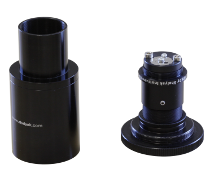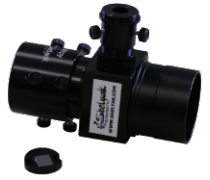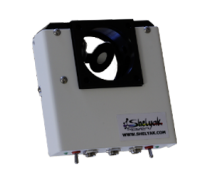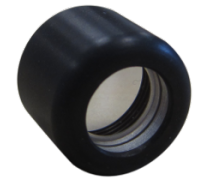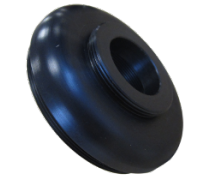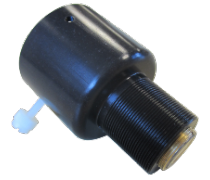Codice articolo: ES0002
![The Lhires III is THE standard High Resolution reference spectroscopy. Gain access to the smallest details in the spectral lines profile and observe the stars’ activity. [EN] The Lhires III is THE standard High Resolution reference spectroscopy. Gain access to the smallest details in the spectral lines profile and observe the stars’ activity. [EN]](https://www.teleskop-express.it/img/cms/ES0002-Lhires-III-dans-malette-T210x187-66.png)
A reference instrument
The Lhires III spectroscope is the “historical” instrument from Shelyak. Designed right after the “Ecole d’Astrophysique” du CNRS (astrophysical school organized by the french national science organization) in 2003 for Be stars observation, it has since found numerous other applications.
Resolution & spectral domain
With a resolution power of R=17.000, it gives access to radial velocities by Doppler effect, as well as incredible details in the lines profile.
The standard gratings is of 2400 lines/mm; this gives the Lhires III its full resolution. It can be quickly replaced by other optional grating modules – that makes the Lhires III a versatile instrument, it is therefore possible to adapt the actual resolution to your suit project. Fainter objects then becomes accessible: Novae, bright comets…
![The Lhires III is THE standard High Resolution reference spectroscopy. Gain access to the smallest details in the spectral lines profile and observe the stars’ activity. [EN] The Lhires III is THE standard High Resolution reference spectroscopy. Gain access to the smallest details in the spectral lines profile and observe the stars’ activity. [EN]](https://www.shelyak.com/wp-content/uploads/SE0006-Module-reseau-1200-T168x150-148.png)
The covered spectral domain is quite limited (around 10nm, because of the high resolution). However, thanks to a micrometer you can choose which central wavelength to observe, within the visible domain (400-750nm).
A lot of for educational project become feasible around the Doppler effect, like measuring the rotation of Jupiter or Saturn.
![The Lhires III is THE standard High Resolution reference spectroscopy. Gain access to the smallest details in the spectral lines profile and observe the stars’ activity. [EN] The Lhires III is THE standard High Resolution reference spectroscopy. Gain access to the smallest details in the spectral lines profile and observe the stars’ activity. [EN]](https://www.shelyak.com/wp-content/uploads/20060626jupiter_c11l2400st7e-900_img_zoom.jpg)
Example of a Jupiter spectrum, showing the planet’s rotation (solar lines are slanted).
Aperture
The F/10 aperture makes the Lhires III specially adapted to Schmidt-Cassegrain telescopes. But it can be easily adapted to any type of telescope, even the fastest (by using a Barlow lens).
Guiding system
Thanks to its reflecting slit, the Lhires III allows to precisely point at a star and track it. A guiding camera (not included) allows to control the telescope movements and ensures an optimal observation.
![The Lhires III is THE standard High Resolution reference spectroscopy. Gain access to the smallest details in the spectral lines profile and observe the stars’ activity. [EN] The Lhires III is THE standard High Resolution reference spectroscopy. Gain access to the smallest details in the spectral lines profile and observe the stars’ activity. [EN]](https://www.shelyak.com/wp-content/uploads/wc-jup2.jpg)
Interchangeable slit
The interchangeable slit included as standard (15-19-23-35µm) allows to adapt the instrument to any observational situation. If needed, you can give priority to either resolution, or luminosity. Other slits are also available (large slits, photometric slits), to extend the capabilities further.
![The Lhires III is THE standard High Resolution reference spectroscopy. Gain access to the smallest details in the spectral lines profile and observe the stars’ activity. [EN] The Lhires III is THE standard High Resolution reference spectroscopy. Gain access to the smallest details in the spectral lines profile and observe the stars’ activity. [EN]](https://www.shelyak.com/wp-content/uploads/se0192-support-fente-lhiii-002_184_w.png)
Mechanical interfaces
The Lhires III is shipped with an adapter for Schmidt-Cassegrain telescope. If needed, an optional 2″ nose piece is also available.
![The Lhires III is THE standard High Resolution reference spectroscopy. Gain access to the smallest details in the spectral lines profile and observe the stars’ activity. [EN] The Lhires III is THE standard High Resolution reference spectroscopy. Gain access to the smallest details in the spectral lines profile and observe the stars’ activity. [EN]](https://www.shelyak.com/wp-content/uploads/LhiresIII_SCT.jpg)
The standard CCD cameras adapter is compliant with Atik cameras (or any camera with a T-mount and 13mm backfocus). A lot of adapter rings are also available for most common cameras (see accessories).
The guiding camera port is C-mount.
Going further with the Lhires III
Beyond the knowledge the Lhires III can give you in astrophysics, it is also a scientific instrument for collaboration between amateurs and professionals: Be stars, variable stars tracking… a lot of publications are based on Lhires III observations.
![The Lhires III is THE standard High Resolution reference spectroscopy. Gain access to the smallest details in the spectral lines profile and observe the stars’ activity. [EN] The Lhires III is THE standard High Resolution reference spectroscopy. Gain access to the smallest details in the spectral lines profile and observe the stars’ activity. [EN]](https://www.shelyak.com/wp-content/uploads/Be_02_zetTau.png)
![The Lhires III is THE standard High Resolution reference spectroscopy. Gain access to the smallest details in the spectral lines profile and observe the stars’ activity. [EN] The Lhires III is THE standard High Resolution reference spectroscopy. Gain access to the smallest details in the spectral lines profile and observe the stars’ activity. [EN]](https://www.shelyak.com/wp-content/uploads/RRLyr-HAlpha.gif)
- Specifiche tecniche:
- Resolution Power R ~17000 (with the 23 µm slit)
Dispersion 0.012nm (pixels 9µm, around Hα) - F/10 Aperture
- Littrow architecture
- Adapter rings for many detectors: CCD cameras, DSLR…
- Reflective slit for precise guiding (4 position slit 15/19/23/35 µm).
- Slit length 8mm
- wavelength selected by micrometer in the whole visible domain (400-700 nm)
- 4 positions slit 15/19/23/35µm, reflective for guiding
- Slit length: 8 mm
- internal argon-neon lamp for calibration
- internal tungsten for flat
- motorised calibration & flat lamps for remote operations
- comes with Schmidt-Cassegrain telescope adapter (backfocus 68.5mm)
- C-mount guiding port (focal ratio: 0.8x) The guiding camera backfocus range is 17.5mm with a C-thread
- acquisition port T mount, backfocus up to 55 mm (DSLR compatible)
- switchable grating module (2400 gr/mm in standard)
- Light: 1,7kg (without camera)
- Compact: 250mm x 200mm x 83mm
- Shipped in a rigid case, including an eye-piece holder, and a tool set for tuning.
Documentazione:
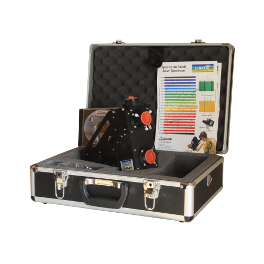 Ingrandisci
Ingrandisci 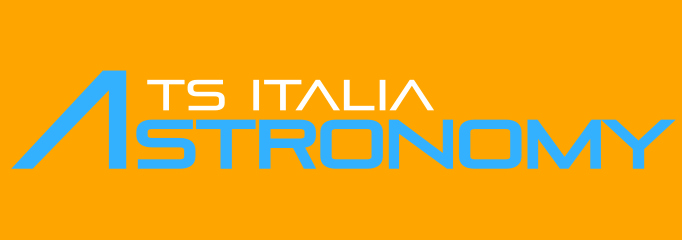
![[USATO] Fornax 52](https://www.teleskop-express.it/img/p/9/9/2/6/9926.jpg)
![[USATO] Astrografo RASA 11″](https://www.teleskop-express.it/img/p/9/1/8/7/9187.jpg)
![[DEMO] Camera QHY 268 Mono BSI](https://www.teleskop-express.it/img/p/6/5/0/1/6501.jpg)

![The Lhires III is THE standard High Resolution reference spectroscopy. Gain access to the smallest details in the spectral lines profile and observe the stars’ activity. [EN] The Lhires III is THE standard High Resolution reference spectroscopy. Gain access to the smallest details in the spectral lines profile and observe the stars’ activity. [EN]](https://www.teleskop-express.it/img/cms/ES0002-Lhires-III-dans-malette-T210x187-66.png)
![The Lhires III is THE standard High Resolution reference spectroscopy. Gain access to the smallest details in the spectral lines profile and observe the stars’ activity. [EN] The Lhires III is THE standard High Resolution reference spectroscopy. Gain access to the smallest details in the spectral lines profile and observe the stars’ activity. [EN]](https://www.shelyak.com/wp-content/uploads/SE0006-Module-reseau-1200-T168x150-148.png)
![The Lhires III is THE standard High Resolution reference spectroscopy. Gain access to the smallest details in the spectral lines profile and observe the stars’ activity. [EN] The Lhires III is THE standard High Resolution reference spectroscopy. Gain access to the smallest details in the spectral lines profile and observe the stars’ activity. [EN]](https://www.shelyak.com/wp-content/uploads/20060626jupiter_c11l2400st7e-900_img_zoom.jpg)
![The Lhires III is THE standard High Resolution reference spectroscopy. Gain access to the smallest details in the spectral lines profile and observe the stars’ activity. [EN] The Lhires III is THE standard High Resolution reference spectroscopy. Gain access to the smallest details in the spectral lines profile and observe the stars’ activity. [EN]](https://www.shelyak.com/wp-content/uploads/wc-jup2.jpg)
![The Lhires III is THE standard High Resolution reference spectroscopy. Gain access to the smallest details in the spectral lines profile and observe the stars’ activity. [EN] The Lhires III is THE standard High Resolution reference spectroscopy. Gain access to the smallest details in the spectral lines profile and observe the stars’ activity. [EN]](https://www.shelyak.com/wp-content/uploads/se0192-support-fente-lhiii-002_184_w.png)
![The Lhires III is THE standard High Resolution reference spectroscopy. Gain access to the smallest details in the spectral lines profile and observe the stars’ activity. [EN] The Lhires III is THE standard High Resolution reference spectroscopy. Gain access to the smallest details in the spectral lines profile and observe the stars’ activity. [EN]](https://www.shelyak.com/wp-content/uploads/LhiresIII_SCT.jpg)
![The Lhires III is THE standard High Resolution reference spectroscopy. Gain access to the smallest details in the spectral lines profile and observe the stars’ activity. [EN] The Lhires III is THE standard High Resolution reference spectroscopy. Gain access to the smallest details in the spectral lines profile and observe the stars’ activity. [EN]](https://www.shelyak.com/wp-content/uploads/Be_02_zetTau.png)
![The Lhires III is THE standard High Resolution reference spectroscopy. Gain access to the smallest details in the spectral lines profile and observe the stars’ activity. [EN] The Lhires III is THE standard High Resolution reference spectroscopy. Gain access to the smallest details in the spectral lines profile and observe the stars’ activity. [EN]](https://www.shelyak.com/wp-content/uploads/RRLyr-HAlpha.gif)
